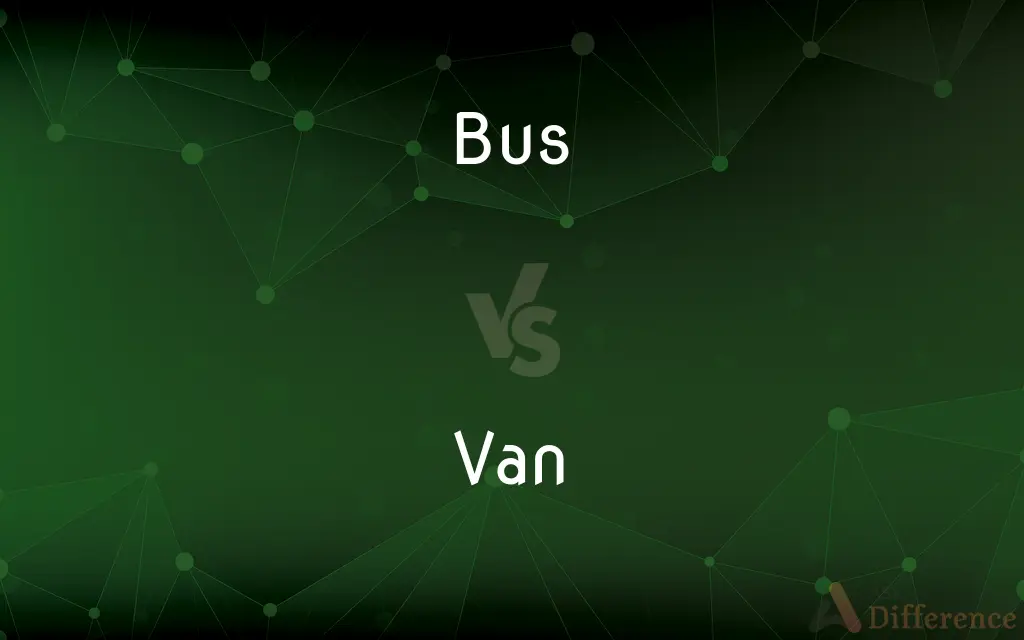Bus vs. Van — What's the Difference?
By Tayyaba Rehman & Urooj Arif — Updated on March 24, 2024
A bus is a large vehicle designed to carry many passengers, often used for public transport, while a van is smaller, versatile for cargo or fewer passengers, suitable for private or commercial use.

Difference Between Bus and Van
Table of Contents
ADVERTISEMENT
Key Differences
Buses are primarily designed for passenger transport, offering multiple seating rows that can accommodate a larger number of people, making them ideal for city routes, school transport, and long-distance travel. Vans, on the other hand, come in various sizes but generally provide seating for fewer passengers, often used for small groups, families, or commercial purposes like deliveries.
The structure of a bus is characterized by its sizeable frame and length, designed to handle the demands of public transportation, including standing passengers and accessibility features like low floors or wheelchair ramps. Whereas vans are more compact, focusing on flexibility and maneuverability in urban environments, with features catering to cargo transport or small group travel.
When it comes to usage, buses serve a broader public service, operating on fixed routes and schedules in urban, suburban, and rural areas. They are integral to public transportation networks. In contrast, vans are more commonly used for private purposes, such as family vehicles, or commercially for goods transport, offering customization options like shelving and refrigeration for specific business needs.
Buses are equipped with amenities aimed at passenger comfort and safety over long distances, including air conditioning, ticketing systems, and sometimes even restrooms on coach buses. Vans, while offering basic comforts, prioritize practicality and space utilization over passenger amenities, focusing on cargo space or specialized equipment for commercial tasks.
In terms of operation, driving a bus typically requires specialized licensing due to its size and the responsibility of carrying numerous passengers. Driving a van, however, often only requires a standard driver's license, making it more accessible for personal or small-scale commercial use.
ADVERTISEMENT
Comparison Chart
Primary Function
Passenger transport
Passenger and/or cargo transport
Capacity
High, designed to carry many passengers
Lower, varies from small to medium groups
Size & Structure
Large, elongated for more seating rows
More compact, versatile in design
Usage
Public transportation, school, and coach travel
Private, family, commercial (e.g., deliveries)
Amenities
Equipped for passenger comfort and safety
Focused on practicality and cargo space
Licensing
Specialized licensing required
Standard driver's license often sufficient
Maneuverability
Less maneuverable due to size
More maneuverable in urban environments
Customization
Limited, focused on passenger needs
Highly customizable for specific uses
Accessibility
Often equipped with accessibility features
Varies, generally less focused on accessibility
Operation Area
Fixed routes and schedules
Flexible usage and routes
Compare with Definitions
Bus
A large motor vehicle designed to carry many passengers along a fixed route.
She takes the bus to work every day to avoid driving in traffic.
Van
Suitable for both personal and commercial use.
The family uses their spacious van for road trips and daily commutes.
Bus
Used for public transportation, including city and intercity travel.
The city introduced new bus routes to improve commuter services.
Van
A medium-sized vehicle used for transporting goods or small groups.
They rented a van to move their furniture to the new house.
Bus
Often equipped with features for accessibility, such as low-entry floors.
The new buses have wheelchair ramps to accommodate all passengers.
Van
Varies in type, including cargo vans and passenger vans.
The company uses cargo vans for their delivery services.
Bus
Can be a school bus, city bus, or luxury coach for long-distance travel.
On their trip, they traveled overnight in a comfortable coach bus.
Van
Offers flexibility for customization, like shelving for tools.
Their van is equipped with custom shelves for all the electrical equipment.
Bus
Requires drivers to have a commercial driving license due to its size.
He's studying for his commercial license to become a city bus driver.
Van
Generally requires only a standard driving license.
She was able to drive the rental van using her regular driver's license.
Bus
A bus (contracted from omnibus, with variants multibus, motorbus, autobus, etc.) is a road vehicle designed to carry many passengers. Buses can have a capacity as high as 300 passengers.
Van
A van is a type of road vehicle used for transporting goods or people. Depending on the type of van, it can be bigger or smaller than a truck and SUV, and bigger than a common car.
Bus
A large motor vehicle carrying passengers by road, typically one serving the public on a fixed route and for a fare
A bus service
Van
An enclosed boxlike motor vehicle having rear or side doors and side panels especially for transporting people.
Bus
A distinct set of conductors carrying data and control signals within a computer system, to which pieces of equipment may be connected in parallel.
Van
A covered or enclosed truck or wagon often used for transporting goods or livestock.
Bus
Transport in a communal road vehicle
Staff were bussed in and out of the factory
Van
Chiefly British A closed railroad car used for carrying baggage or freight.
Bus
Remove (dirty plates and dishes) from a table in a restaurant or cafeteria.
Van
The vanguard; the forefront.
Bus
A long motor vehicle for carrying passengers, usually along a fixed route.
Van
A wing.
Bus
(Informal) A large or ungainly automobile.
Van
A winnowing device, such as a fan.
Bus
A four-wheeled cart for carrying dishes in a restaurant.
Van
To transport by van
Vanned the horses to the racetrack.
Bus
(Electricity) A bus bar.
Van
To drive or travel in a van
Vanned around the country.
Bus
(Computers) A parallel circuit that connects the major components of a computer, allowing the transfer of electric impulses from one connected component to any other.
Van
A covered motor vehicle used to carry goods or (normally less than ten) persons, usually roughly cuboid in shape, longer and higher than a car but relatively smaller than a truck/lorry or a bus.
The van sped down the road.
Bus
To transport in a bus.
Van
(British) An enclosed railway vehicle for transport of goods, such as a boxcar/box van.
Bus
To transport (schoolchildren) by bus to schools outside their neighborhoods, especially as a means of achieving racial integration.
Van
(dated) A light wagon, either covered or open, used by tradesmen and others for the transportation of goods.
Bus
To carry or clear (dishes) in a restaurant.
Van
(aerospace) A large towable vehicle equipped for the repair of structures that cannot easily be moved.
Bus
To clear dishes from (a table).
Van
Clipping of vanguard
Bus
To travel in a bus.
Van
(mining) A shovel used in cleansing ore.
Bus
To work as a busboy.
Van
A fan or other contrivance, such as a sieve, for winnowing grain.
Bus
(automotive) A motor vehicle for transporting large numbers of people along roads.
Van
A wing with which the air is beaten.
Bus
An electrical conductor or interface serving as a common connection for two or more circuits or components.
Van
(transitive) To transport in a van or similar vehicle (especially of horses).
Bus
Part of a MIRV missile, having on-board motors used to deliver the warhead to a target.
Van
Of law enforcement: to arrest (not necessarily in a van; derived from party van).
Bus
An ambulance.
Van
(mining) To wash or cleanse, as a small portion of ore, on a shovel.
Bus
To transport via a motor bus.
Van
The front of an army; the first line or leading column; also, the front line or foremost division of a fleet, either in sailing or in battle.
Standards and gonfalons, twixt van and rear,Stream in the air.
Bus
To transport students to school, often to a more distant school for the purposes of achieving racial integration.
Van
A shovel used in cleansing ore.
Bus
To travel by bus.
Van
A light wagon, either covered or open, used by tradesmen and others for the transportation of goods.
Bus
To clear meal remains from.
He bussed tables as the restaurant emptied out.
Van
A large covered wagon for moving furniture, etc., also for conveying wild beasts, etc., for exhibition.
Bus
To work at clearing the remains of meals from tables or counters; to work as a busboy.
He’s been bussing for minimum wage.
Van
A closed railway car for baggage. See the Note under Car, 2.
Bus
An omnibus.
Van
A fan or other contrivance, as a sieve, for winnowing grain.
Bus
A vehicle carrying many passengers; used for public transport;
He always rode the bus to work
Van
A wing with which the air is beaten.
He wheeled in air, and stretched his vans in vain;His vans no longer could his flight sustain.
Bus
The topology of a network whose components are connected by a busbar
Van
To wash or cleanse, as a small portion of ore, on a shovel.
Bus
An electrical conductor that makes a common connection between several circuits;
The busbar in this computer can transmit data either way between any two components of the system
Van
To fan, or to cleanse by fanning; to winnow.
Bus
A car that is old and unreliable;
The fenders had fallen off that old bus
Van
Any creative group active in the innovation and application of new concepts and techniques in a given field (especially in the arts)
Bus
Send or move around by bus;
The children were bussed to school
Van
The leading units moving at the head of an army
Bus
Ride in a bus
Van
A camper equipped with living quarters
Bus
Remove used dishes from the table in restaurants
Van
A truck with an enclosed cargo space
Common Curiosities
Can a van be used for public transportation?
While vans can be used for small-scale public transport like shuttle services, they are not typical for larger public transit systems.
Can buses be used for private purposes?
While uncommon, private entities can own buses for specific purposes, such as private tours or as part of a corporate campus.
Are there electric versions of buses and vans?
Yes, there are electric models available for both, catering to the growing demand for sustainable transportation options.
What is the main difference between a bus and a van?
The main difference is size and purpose; buses are larger and designed for public passenger transport, while vans are smaller and serve diverse needs, including cargo transport.
Is it more economical to operate a van or a bus?
Vans are generally more economical due to their smaller size and lower operating costs, making them suitable for private or small business use.
How do maintenance costs compare between buses and vans?
Buses typically incur higher maintenance costs due to their size and complexity, while vans are generally less expensive to maintain.
Are all vans suitable for carrying cargo?
Not all, as some are specifically designed for passengers, but many vans are versatile and can be adapted for cargo.
Do you need a special license to drive a bus?
Yes, driving a bus usually requires a commercial driving license due to its size and the number of passengers.
What is a minibus?
A minibus is a smaller version of a bus, designed to carry fewer passengers, bridging the gap between a van and a full-sized bus.
Can vans have passenger seats?
Yes, many vans come equipped with passenger seats and are used for transporting small groups.
Can you rent buses and vans for personal use?
Yes, both buses and vans are available for rent, catering to various needs like group travel, events, or moving.
How are buses and vans adapted for accessibility?
Buses often have features like low floors and wheelchair ramps, while vans can be modified with equipment like lifts and ramps for accessibility.
What are the environmental impacts of buses vs. vans?
Buses can be more efficient in terms of emissions per passenger, especially in congested urban areas, while vans offer efficiency for smaller groups or cargo.
What safety features are common in buses and vans?
Both come equipped with safety features like seat belts and airbags, but buses may also include additional safety measures due to their passenger capacity.
Are there luxury options for buses and vans?
Yes, luxury options are available for both, offering enhanced comfort, amenities, and technology for passengers.
Share Your Discovery

Previous Comparison
Estimate vs. Estimative
Next Comparison
Superhero vs. HeroAuthor Spotlight
Written by
Tayyaba RehmanTayyaba Rehman is a distinguished writer, currently serving as a primary contributor to askdifference.com. As a researcher in semantics and etymology, Tayyaba's passion for the complexity of languages and their distinctions has found a perfect home on the platform. Tayyaba delves into the intricacies of language, distinguishing between commonly confused words and phrases, thereby providing clarity for readers worldwide.
Co-written by
Urooj ArifUrooj is a skilled content writer at Ask Difference, known for her exceptional ability to simplify complex topics into engaging and informative content. With a passion for research and a flair for clear, concise writing, she consistently delivers articles that resonate with our diverse audience.














































